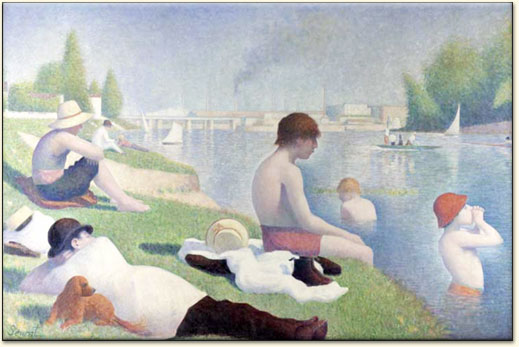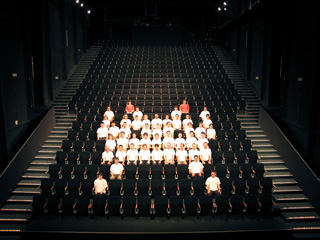
starting off with the mosaic, altho not a form strictly gridded by any means -

as well as the worlds apon worlds of cross-stitch


including a image to cross-stitch template generator
and onto beadwork

then on thru pointilism, again not strictly pixelation as the technique relies on the eye clouding together primary coloured dots into secondary colours, from my basic research, rather than each point representing an independant colour value - tho each dot would obviously dictate the overall form of the image -


the above is an example of not-really-pointilism
and also a pointilism patch for processing
then onto pinboard technique - an animation technique reserved for the slightly insane but none the less beautiful - brought to prominence by animators Alexander Alexeïeff & Claire Parker (Russian and American respectively), which is the very amazing technique of pushing pins in (negative space) or pulling them out (positive space) to a certain point on a pinboard matrix. and doing that alot for a very long time. looking forward to seeing the examples of their work in the ACMI lending collection next week (have to book ahead to view 16mm) - good related article on pinscreen here and lo-res google video of one of their works here


and from there I'm jumping to the concept of the bitmap image, and, well, off you go down that merry path of raster-based imagery and software and technology, from the first computer images (or did ascii pictures come first?) thru to mobile phones and basically all electronically-generated or displayed imagery in-between, film notwithstanding (until it's digitized). My understanding on all this is still slightly mushy but the point is getting to the very interesting offshoots on the concept of the pixel to pop up in the last decade, and how that relates to our perception of the image, and the moving image especially, both in a figurative and abstract form.
such as:

Jim Campbell's LED video works - one of my first experiences with this type of thing
Aram Bartholl's work - so simple, so so good - pieces for now - using tealight candles as light sources and convection for abstact pixelation, and simple techniques to quantify TV down to a "pleasing information density" as he calls it:


TV Filter



Random Screen

Paper Pixels

Bitwall 4 - Christian Moeller
- a series of stills converted into bitmap images via plastic chips produced by taking scans of the origional image (inmate portraits) and producing chips which were then re-constructed on a large vertical grid - depends on light and point of view (ie sufficiently far away from the image) for the pictures to render - which reminds me of Fabrizio Corneli's work and his use of shadow to create installed imagery like Augenblicke, even tho not pixelation.

Crayon Head - Ian Wright
Ian also does a great deal of pin (i guess you could say pinboard) pixelation art, great stuff -

Aether Architecture
- lots of abstracted pixel investigations - particularly Ping Genus Loci and Induction House

Open Burble by Haque Design
- installation using baloons with LED lights within - not actually aiming for pixelation as such, but more as an interactive installation which is a paticipatory event. seems to be just waiting for the LED's to be programmable by those participants...

Greyworld's The Source -
Built as the main hall installation for the London Stock Exchange, this kinetic (ish) sculture trades (ha) off datasets such as the value of the pound etc to manipulate and dictate its movement, behaviour and colour. it also helpfully spells out words and symbols. Quite an interesting project in many ways, not the least of which in the fact that an interactive abstracted installation got up in the first place in this context.

Eavesdripping - Sascha Pohflepp
- now onto the tasty stuff - - drips as pixels and the new boundaries of 'physical displays' which rely on a host of techniques to produce either still or moving images. I like eavesdripping as a project because, altho the bitmap (dripmap) it is creating is essentially a still image (a line, a word), by the nature of its bits/drips it becomes more than a static display, and futher more it is getting into very interesting territory regarding elemental and organic substances being used within the interface...
Electroland is doing some interesting work using windows, neon a also resilient LED in-floor systems to create a bunch of interactive projects based on pphysical displays, but their website's flash based so no pics

The OG and in many ways still unsurpassed (and open source) interactive physical display.... Blinkenlights
- an unexciting east-german office block in AlexanderPlatz, Berlin, a large number of floor lamps and extension leads and the sort of gumption that only a lack of arts funding can provide, in 2001 the Chaos Computer Club began what has been an ongoing project in a variety of forms - including some pretty impressive stuff in Paris - I've particularly liked the very stong usability of the animation creation systems and applets this crew have used, and the fact that it has consistently been opened up to contributors. And the fact that it is so darn ground-up. This was the first project of this type I ever encountered (Berlin 2002), and I still rate it up there in pure groundswell and effectiveness as a community (both located and virtual) tool and experience.

Bitfall by Spherical Robots
- a programmable waterfall - akin to Eavesdripping (well not really but it's a physical display using water) but viewed on the vertical, the falling droplets compose the image (rather than the droplets hitting a surface, in eavesdripping). Pretty snazzy, to me part of the appeal is the destruction of the image, the instantaneous deconstruction into a puddle from such an intensely acknowledged image... interesting... similar implications as eavesdripping around the still image composed of moving elemental form...

Infernoptix
- pyrotechnic physical display - impress yr friends...not sure how effective this invention is, altho there's some interesting elemental aspects, for me...
Interactive Waterfall by Charles Forman
- nice use of low-res type physical display using LED's to create a simple interactive installation for a childrens hospital. I Like this work in that it is responsive in a vaguely figurative way, rather than an abstracted interactive way, given that it's in a kids hospital - and therefore an environment with alot of implications towards the physical... elegant ly chilled yet highly responsive - i like. also behind water I should add.

Space invaders by Guillaume Reymond -
- animation of a complete game of space invaders using people as pixels in a lecture hall - video here
that's the main ones I've got so far - I should be seperating the still from the moving I realise, but they feel quite entwined for me - praps cause the still works still require perception and relocation in order to view the works properly and from all their angles, and also the majority of the moving image ones are still in the slow realm of a chugging series of stills, so they are operating across picture-making and also moving image and animation. I think there are some very interesting questions around perception of image and the relationships inherent to physical displays which function in this way, and also how our visual literacy at this point in history impacts apon these things...
if anyone has other examples of bit map or pixelish encounters to suggest, muchly appreciated...

No comments:
Post a Comment